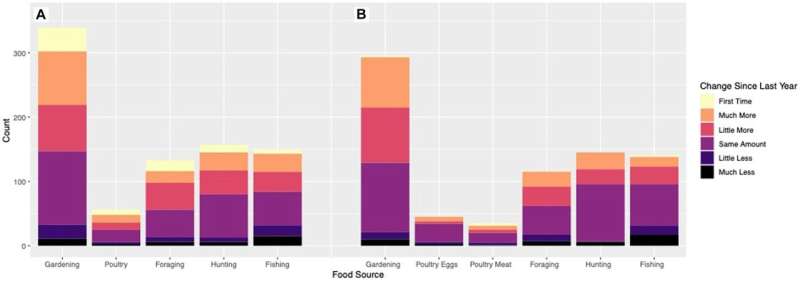This article has been reviewed according to Science X's editorial process and policies. Editors have highlighted the following attributes while ensuring the content's credibility:
fact-checked
peer-reviewed publication
trusted source
proofread
Pandemic found to have boosted gardening, hunting in New York State

A survey of New York state residents found that nearly half of respondents increased the amount of time they spent on wild and backyard food in the early months of the COVID-19 pandemic—confirming anecdotes about increases in activities such as sourdough baking, fishing and gardening.
People also tended to eat the food they produced, researchers found, possibly buffering the generally less healthful eating that was common at the time.
"This was the period of 2020 when you couldn't find tomato cages, seeds were out of stock, and there were reports about record numbers of people hunting and fishing," said Kathryn Fiorella, assistant professor in the Department of Public and Ecosystem Health at the College of Veterinary Medicine and senior author of "Wild and Backyard Food Use During COVID-19 in Upstate New York, United States," published in the journal Frontiers in Nutrition.
Her advisee, Jeanne Coffin-Schmitt, a doctoral student, had already been thinking about wild and backyard foods in upstate New York and whether people were motivated by fun, food or personal fulfillment to pursue them. "Then, during lockdown, we saw that interest was ballooning, so we quickly launched an online survey to understand what COVID-19 was changing," she said.
The project brought together researchers from both Fiorella's group, the Master of Public Health Program, and Coffin-Schmitt's department. "We are trying to think about the interconnections between health and the environment in the new Department of Public and Ecosystem Health, and this is one example of the topics we consider when thinking about the food system very broadly," Fiorella said.
The group conducted a survey of more than 500 people across six counties in upstate and central New York. Participants reported on their production and consumption of wild and backyard foods—from gardening, poultry rearing, foraging and hunting and/or fishing—during the pandemic compared with the previous year. Because respondents were recruited in a convenience sample, they likely overrepresented interest in these activities. They also tended to be whiter, more educated and wealthier than average New Yorkers.
Results showed that only a small number of participants were new to wild and backyard food-related pursuits, and across different activities, 40% to 46% of people increased the amount of time they invested. Conversely, a notable minority of respondents reduced their activities, possibly because they were essential workers or parents with children suddenly at home.
The researchers were especially interested to see whether people also consumed the food they produced. Indeed, they did. While diets generally worsened during the pandemic, gardening and poultry rearing for meat and eggs may have contributed to buffering those effects in the study region.
"People were actually consuming really meaningful quantities," Fiorella said, including home-produced eggs and meat, and backyard-grown fruits and vegetables.
"People reported harvesting and eating wild and backyard foods to have more control over food availability—a key dimension of food insecurity—compared to before the pandemic," Coffin-Schmitt said. "This was true even though the people we surveyed were almost entirely considered food secure based on their responses. We think this could show how much anxiety about conventional food systems the pandemic inspired."
The study also draws attention to the wealth of local know-how already available.
"Participating in these activities brings you into this network, where you share both food and knowledge with each other," Fiorella said. She hopes that the study will help agencies with a strong interest in supporting people in hunting, fishing and gardening—including the state's Department of Environmental Conservation and the network of Cornell Cooperative Extension offices—tap into existing resources while providing more targeted assistance to communities.
"Experience with these activities lets people access them in a crisis, which we may need in the future, given not only the possibility of future pandemics but of other climate and environmental challenges we might face," she said.
More information: Jeanne L. Coffin-Schmitt et al, Wild and backyard food use during COVID-19 in upstate New York, United States, Frontiers in Nutrition (2023). DOI: 10.3389/fnut.2023.1222610
Journal information: Frontiers in Nutrition
Provided by Cornell University

















